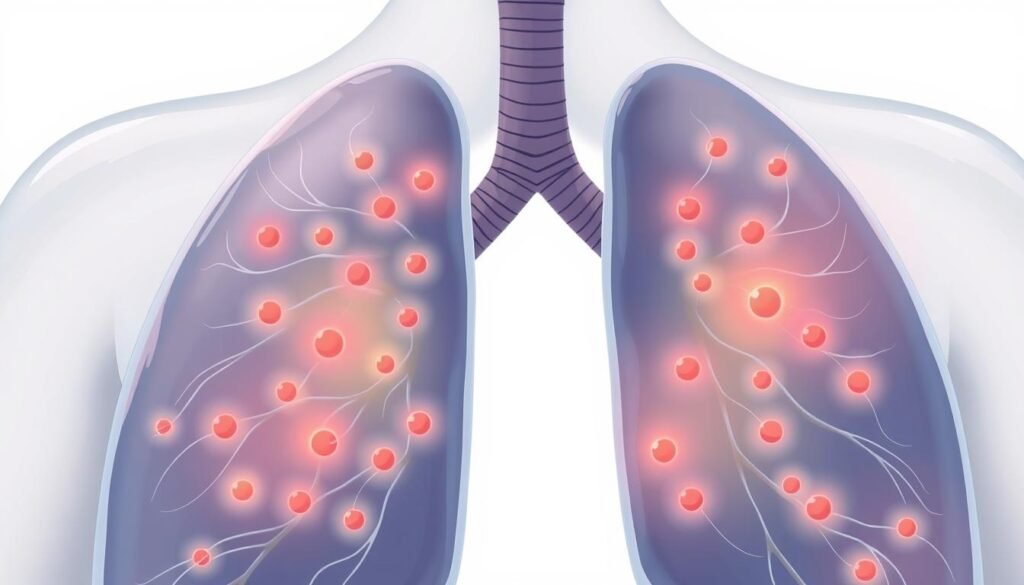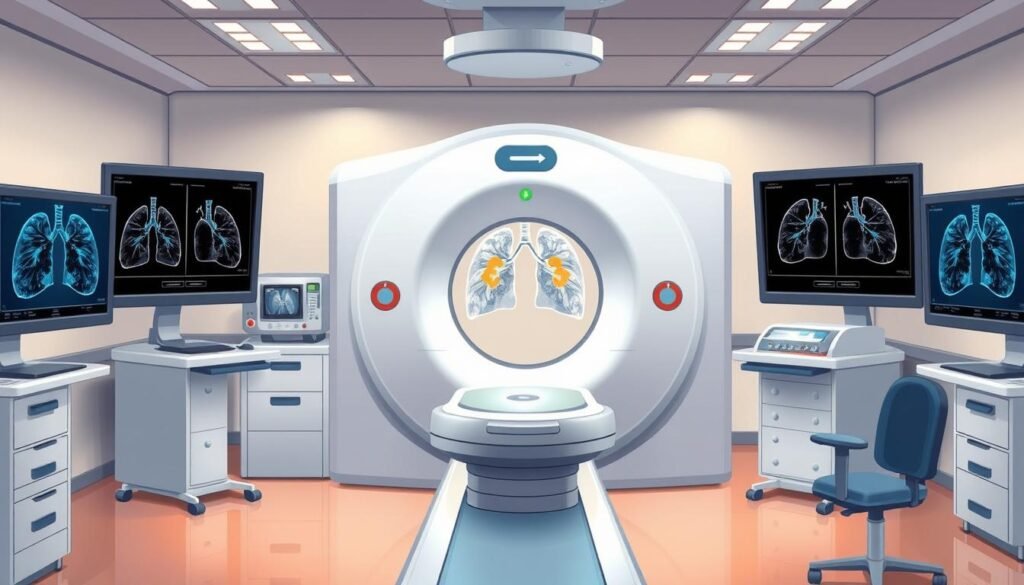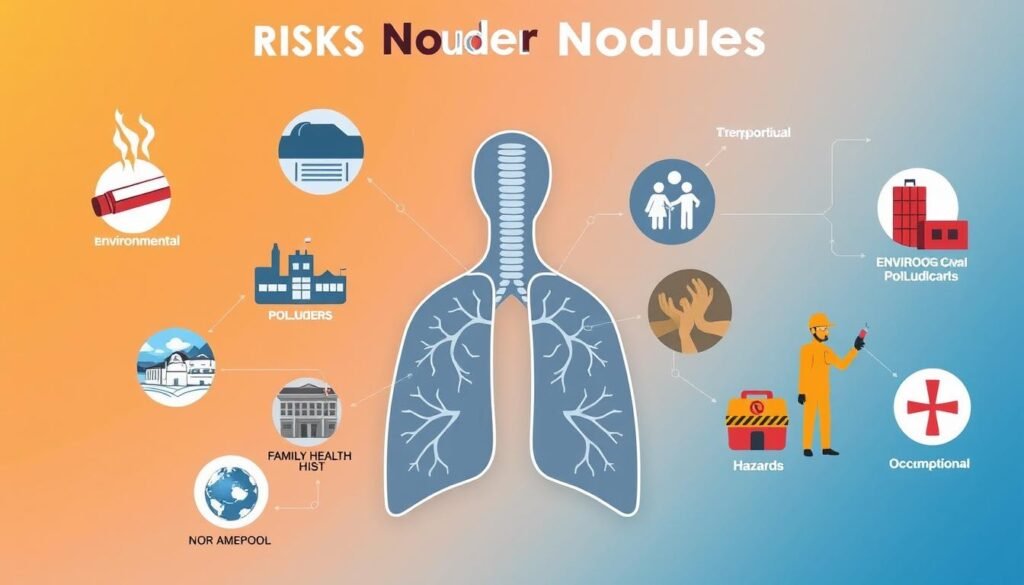Did you know over 90 percent of pulmonary nodules are found by chance? They’re often seen in chest X-rays or CT scans done for other reasons. These nodules are small growths in the lungs, up to 3 centimeters wide. They can cause worry when found unexpectedly. Although the fear of lung cancer is common, most lung nodules aren’t cancerous.
Understanding what lung nodules are and how they’re detected is key. This knowledge is essential for what comes next in healthcare. Tests are usually needed to see if a nodule is harmful. Knowing about this condition can calm fears and help patients talk better with their doctors. For more information, including actions to take if you find lung nodules, visit this link.
Key Takeaways
- Lung nodules are small growths in the lungs, commonly found during imaging tests.
- Most lung nodules are benign and not indicative of cancer.
- Regular monitoring through CT scans may be required to track the changes in lung nodules.
- Determining the cause of a lung nodule may require a series of tests, including biopsies.
- Awareness of factors such as age, smoking, and family history can aid in assessing risks associated with lung nodules.
Lung Nodules Definition
Lung nodules are small, rounded masses in lung tissue. They show up as white spots on chest X-rays or CT scans. Usually, they’re smaller than 3 centimeters. Knowing what they are helps both health professionals and patients understand lung health better.
Many lung nodules are harmless, resulting from past lung infections. However, some are caused by infections or even cancer. Identifying these nodules helps with the choice of treatment or monitoring.
It’s key to look at a nodule’s size, shape, and how fast it grows. These factors help decide the best approach for managing them.
Getting accurate info about lung nodules is crucial for awareness. Sites like TNM staging for lung cancer offer insights on how these abnormalities relate to cancer.
What are Lung Nodules, and How are They Discovered?
Lung nodules are small masses inside the lungs. They are usually found by chance during tests for other health issues. It is crucial to know how we find lung nodules. This helps in keeping an eye on them and treating them if needed.
Incidental Findings on Imaging
Many lung nodules show up by chance on imaging tests. About 1 in 500 chest X-rays reveal a lung nodule. This shows how key these imaging tests are. When nodules are found, doctors often do more tests. They want to know if the nodules are harmless. It’s very important to keep checking these nodules over time.
X-rays vs. CT Scans
Knowing the difference between an X-ray and a CT scan is important for treatment. Chest X-rays can spot lung nodules. But, CT scans give a clearer picture. They help doctors see the nodule’s size and any changes. Often, doctors choose CT scans first for their detailed accuracy.
| Imaging Technique | Detection Rate | Details |
|---|---|---|
| X-ray | 1 in 500 | Basic imaging technique, often used for initial evaluations. |
| CT Scan | Higher than X-ray | Provides detailed images for measuring and observing nodules over time. |
Regular imaging helps doctors learn about lung health and any risks. Working with healthcare providers is key to looking after lung health. For more about lung nodules, including in-depth information, visit this resource.
Common Causes of Lung Nodules
Lung nodules may have various sources. These sources affect how they’re diagnosed and treated. Knowing why lung nodules happen is key for deciding how to manage them. Causes are infectious or non-infectious, each with unique features.
Infectious Causes
Infections can lead to lung nodules. This usually happens after lung diseases. Conditions like:
- Tuberculosis
- Fungal infections
These can cause nodules as the body fights off the germs. It’s important to understand these infections for proper treatment.
Non-infectious Causes
Non-infectious reasons include benign tumors and other issues. For example:
- Rheumatoid arthritis
- Sarcoidosis
These can show up as nodules, usually benign. Identifying the cause is crucial for the right treatment or tests.
| Cause Type | Common Causes | Characteristics |
|---|---|---|
| Infectious | Tuberculosis, Fungal Infections | Inflammation, Previous infection markers |
| Non-infectious | Rheumatoid Arthritis, Sarcoidosis | Benign, Typically not cancerous |
Lung Nodules Symptoms
Most people with lung nodules do not show any symptoms, with about 95% not feeling anything. These nodules are usually found by accident during chest X-rays or CT scans. If symptoms of lung nodules appear, it might mean a serious condition. Early detection of symptoms is key for getting the right treatment.
When Symptoms Occur
Symptoms usually start when a nodule grows or is near an airway. People might experience:
- Chronic cough
- Shortness of breath
- Blood-tinged mucus
Seeing these signs should make someone see a doctor quickly.
Possible Warning Signs
Knowing the warning signs of lung nodules is crucial for health. Less than 5% of lung nodules are cancer, but some risks exist. These risks include:
- Being older, which increases risk
- Having larger nodules, especially those over 0.6 cm
- A history of smoking, as it’s linked to 90% of lung cancers
- A family history of cancer
Understanding these risks and recognizing symptoms helps people get the care they need.

Lung Nodules Diagnosis
The lung nodules diagnosis process starts with imaging like chest X-rays or CT scans. Through these scans, doctors can spot the nodules. The shape of nodules in these images helps decide if more tests are needed.
The chance of a nodule being cancerous grows with certain risk factors. Being over 50, smoking, or having family with lung cancer increases risk. The size, growth, and shape of the nodule are key in diagnosis.
If the nodules look odd, more tests like a biopsy may be done. This test takes a piece of the nodule to check in a lab. This helps doctors figure out if the nodule is cancerous or not.
Many adults, about 50%, have nodules seen in chest CT scans. But, less than 5% of these nodules are cancerous. Low-risk noncancerous nodules might just be watched over time with more scans. This careful watching is crucial in lung nodule diagnosis.
| Characteristic | Malignant Nodule | Benign Nodule |
|---|---|---|
| Size | Larger than 0.6 cm | Often smaller |
| Growth Rate | Fast-growing | Stable or slow-growing |
| Shape | Irregular or prickly borders | Smooth borders |
| Symptoms | Often symptomatic | Usually asymptomatic |
Lung Nodules Screening
Lung nodules screening is key in catching lung cancer early. Most lung nodules are small and not cancer. But, regular checks are advised, especially for those at high risk like smokers or older adults. CT scans are the top choice for screening. They can spot changes in lung nodules well.

Screening often finds nodules first, leading to more tests. If a nodule looks odd, a CT scan gives more details. These nodules are usually from past infections or scar tissue, not cancer. Yet, repeat CT scans are needed. They check if the nodule grows over months or a year.
If scans show a nodule growing or looking worrisome, a biopsy may be needed. This test can confirm cancer. It might use a scope down the throat or a needle through the chest. Experts at places like Fox Chase Cancer Center quickly handle these cases. They offer next-day assessments.
Biopsy results come back in a few days. They show if the nodule is an infection, cancer, or something else. If it’s an infection, a specialist in infectious diseases might step in. Following regular screening guidelines helps at-risk folks get the care they need.
Lung Nodules Treatment
The way to treat lung nodules depends on various things like their size and the patient’s health history. It’s key to look at aspects such as their size, how they look, and if they’ve changed over time. Small nodules that don’t change much are usually just watched with regular scans. This means doctors can keep an eye on the nodule without rushing into any treatments.
Observation and Monitoring
Observation and monitoring are often key steps in handling lung nodules. Doctors usually suggest follow-up scans to check for any changes in the nodules. If a nodule stays the same, it might not need further action. But, if it grows or looks worrisome on later scans, doctors might think about more serious treatments, like dealing with cancerous nodules.
When is Treatment Needed?
Deciding if treatment is needed depends on the nodule’s traits, the patient’s past health, and cancer risk factors. A history of smoking can greatly affect cancer chances, especially in those 50 to 80 years old with a long smoking history. These folks are often advised to get yearly scans to catch any problems early.
Doctors will look at the nodule’s size and place, and any changes seen over time, before opting for treatment. In cases where nodules look very suspicious, a biopsy might be suggested. Those with concerning tests or big changes should go to specialized centers like Roswell Park. They offer expert advice and many treatment choices.
| Nodule Characteristic | Observation Criteria | Treatment Options |
|---|---|---|
| Small and Stable | Regular imaging and monitoring | No immediate treatment |
| Growing or Concerning Features | Further imaging to assess changes | Surgery, targeted therapies, biopsy |
| Suspicious Nodule | High-risk assessment, biopsy if needed | Potential surgery, close monitoring |
Lung Nodules Risk Factors
Many factors contribute to the development and possible malignancy of lung nodules. It’s vital to understand these factors for effective screening and monitoring. Factors related to demographics and the environment greatly affect an individual’s risk.
Demographic Factors
Demographic elements are key in lung nodule risk assessment. Notable factors include:
- Age: Older people, especially those with a history of smoking, are at higher risk.
- Smoking History: Being a current or former smoker increases the chance of developing cancerous nodules.
- Family Medical History: Having a personal or family history of lung cancer raises the risk of lung nodules.
Environmental Factors
Environmental elements also critically affect lung nodule risk. Important factors are:
- Exposure to Hazardous Substances: Working with toxins and pollutants can raise the risk of lung nodules.
- Pollution: High air pollution levels are linked to lung nodule development.
- Radon Exposure: Radon exposure is a significant risk, closely associated with lung cancer.

By keeping these lung nodule risk factors in mind, both patients and healthcare providers can be proactive. Understanding how demographic and environmental factors affect lung health helps in making informed screening and treatment choices.
Lung Nodules Prognosis
The outlook for lung nodules changes depending on if they are benign or malignant. People need to know this difference. This knowledge helps manage their health expectations. Over half of single lung nodules are benign, meaning they often don’t need much treatment to result in good outcomes for lung nodules.
Understanding the difference between benign and malignant nodules is key. Some lung nodules can turn into lung cancer. Lung cancer is the number one cause of cancer deaths in the USA. Each year, it’s expected that over 225,000 Americans will be diagnosed with it. This fact shows why it’s crucial to watch lung nodules closely for early signs of cancer.
Certain models help spot lung cancer risk by looking at clinical signs and nodule features. They are about 73% accurate in predicting lung cancer. High-risk individuals have a much greater chance of getting lung cancer than those seen as low risk. This proves how vital good testing and regular checks are for figuring out lung nodule outcomes.
Prognosis talks should consider age, past health, and features of the nodules like their size and shape. If lung cancer hasn’t spread, there’s more than a 50% chance of living past five years. But, if it has spread, the chance drops to just over 5%. Knowing these facts is crucial for choosing treatments and discussing care with patients.
Lung Nodules Management
Managing lung nodules well means doctors and patients need to talk clearly with each other. They start by using CT scans to check the nodules regularly. This helps figure out if a nodule is okay or if it could be cancer.
Watching nodules that are not harmful closely is key. This means more CT scans to see any changes. If a patient has many nodules, it doesn’t always mean cancer. Most lung nodules are actually safe.
If lung cancer is found, surgery might be the best choice to try for a cure. If the cancer has spread, doctors may use treatments like chemo, radiation, and immunotherapy. The British Thoracic Society has guidelines. They say small nodules, those under 5 mm, usually don’t need much worry.
Making good choices for your lungs is important. If you smoke, stopping can help a lot. Avoiding bad air and chemicals also helps keep your lungs healthy.
Talking to cancer doctors can help find the best way to treat your lung nodules. For more help, checking out top lung cancer doctors can be useful.
Being involved in treatment choices helps patients get care that fits them best. Staying on top of health appointments is crucial for good lung care.
| Type of Nodule | Treatment Options | Monitoring Frequency |
|---|---|---|
| Benign Nodules | Observation, Lifestyle Changes | Every 6-12 months |
| Slow-Growing Nodules | Regular CT Scans | Every 3-6 months |
| Malignant Nodules | Surgery, Chemotherapy, Radiotherapy | As needed based on treatment plan |
Conclusion
Lung nodules often seem scary but are usually not harmful. Knowing about lung nodules helps people take control of their health. Around 150,000 nodules are found each year in the U.S. It’s key to educate and calm any worries about them.
It’s important to know that lung nodules are not rare. Many factors can affect whether they are serious or not. It helps to talk openly with doctors, especially if you have risks like being older, smoking, or family health issues.
Getting the right care and keeping an eye on lung nodules can lead to better health. Catching and treating them early is essential. This means staying informed and active in your health care is very important.